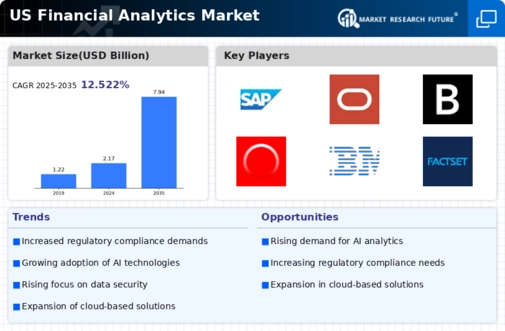The competitive landscape of the US Financial Analytics Market showcases a diverse array of players that are driving innovation and enhancing analytical capabilities aimed at improving financial performance and regulatory compliance. Financial analytics is increasingly integral in helping organizations to make informed decisions through insightful data analysis and visualization tools. As the market evolves, it is marked by growing demand for advanced analytics, machine learning, and artificial intelligence to obtain actionable insights from complex financial data sets.
Firms are focusing on enhancing their product offerings and establishing strategic partnerships to maintain a competitive edge, while also addressing the unique needs of American organizations across various sectors.
This environment fosters robust competition, with leading companies vying for market share by investing in technology upgrades, expanding their service suites, and increasing their penetration in both urban and regional markets throughout the United States.SAP has established a potent presence in the US Financial Analytics Market, leveraging its comprehensive suite of software solutions to empower organizations with advanced data processing capabilities. The company's strength lies in its ability to seamlessly integrate financial data across multiple business units, thus providing stakeholders with a holistic view of their financial health.
SAP's solutions focus on enhancing real-time visibility, enabling executives to make timely decisions based on updated financial information.
Through consistent innovations and an emphasis on customer engagement, SAP has cultivated strong relationships with a diverse range of clients, including large enterprises and mid-sized corporations, ensuring its relevance and adaptability in the dynamic market. In addition, SAP’s focus on industry-specific solutions allows it to tailor offerings that meet the distinctive requirements of different sectors, enhancing its competitive positioning in the US.FTSE Russell plays a significant role in shaping the US Financial Analytics Market, offering a suite of financial services that includes index development, analytics, and benchmarking solutions.
The company's key products revolve around a wide range of indices that are essential for investment performance measurement, enhancing market participants' ability to assess risks and opportunities.
FTSE Russell's strengths are rooted in its rich data analytics capabilities, which blend comprehensive market data with cutting-edge analytical tools, facilitating in-depth insights for asset managers, institutional investors, and other financial professionals. With a strong focus on innovation, FTSE Russell has engaged in strategic partnerships and acquisitions to expand its market reach and enhance its product offerings. The firm’s commitment to transparency and governance further establishes its credibility in the US financial ecosystem, driving continuous demand for its analytics solutions amongst firms looking to optimize their investment decisions.





















Leave a Comment